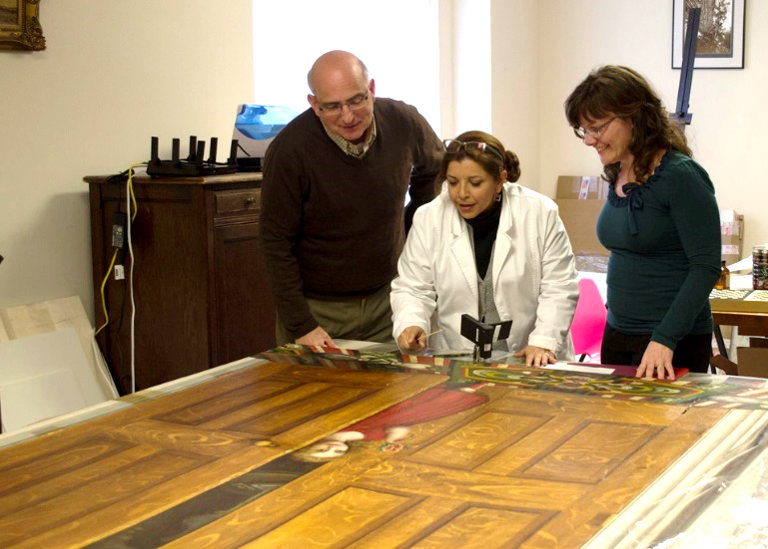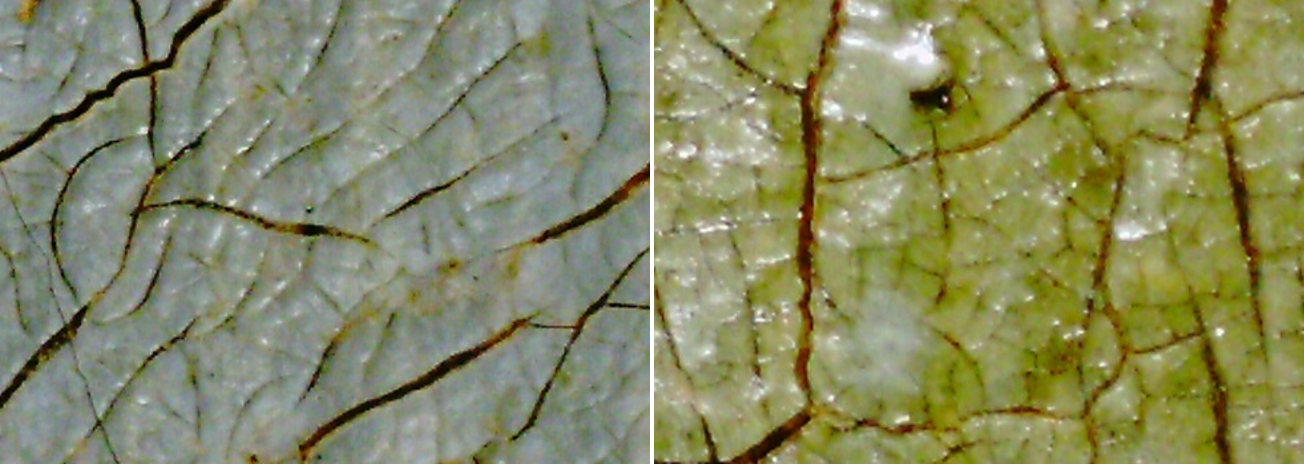Posts Tagged by clara deck
Opening the Door to Preservation

“Opening the Door” is an unusual and large ( 6 feet tall and 4 feet wide) painting that recently received some much-needed conservation here at The Henry Ford.
Painted in the 1840s by self-trained artist George W. Mark, it depicts a young girl holding a flower. She stands in an elaborately-painted open doorway. Behind the girl a bust and lamp are visible on the table in a very shadowy room. The intent is to present a life-size vision that fools the eye into thinking that we are looking into a real space.
If you have the opportunity to take part in a VIP or Special Access tour of our Benson Ford Research Center storage, you will see this painting. It is greatly admired and it is positioned in a prominent location in the state-of-the-art storage facility here at The Henry Ford.
The painting needed conservation attention because it was not in stable condition after years of storage and many moves. Some of the damages were due to the challenges of handling – the painting is not framed, so corners got crushed when it was set down with too much force. And past attempts to hang it resulted in old patched holes near the top.
Take a look behind the scenes to see some of our work conserving "Opening the Door." This project was made possible by the generous support of The American Folk Art Society and Susan and Henry Fradkin. Curator of Decorative Arts Charles Sable, Conservator Celina Contreras de Berenfeld, and Senior Conservator Clara Deck examine the work in progress.
Curator of Decorative Arts Charles Sable, Conservator Celina Contreras de Berenfeld, and Senior Conservator Clara Deck examine the work in progress.
This image shows the last old, yellowed varnish as it was removed from the paint surface.

This is a microscopic image of the thick varnish, before and during removal. The cracks (which are actually quite small!) are expected in a painting of this age and type.
Many paintings suffer over time due to the natural aging that darkens the once-clear protective varnish coat. As the varnish darkens, it shifts colors that were originally intense and bright; they become murky and brownish. Varnish removal restores the painting’s original colors. It is not unusual for old varnishes to require renewal, and this was done as part of an extensive conservation treatment completed last year.
Old patches were also redone so that they are invisible from the front and the whole painting was lined with stable backing material to support its large size. The restoration of damaged areas of the paint was done by “in-painting” only the small areas of lost paint. Finally a new, reversible varnish was applied overall.
The final result is a stronger, stable painting that can survive for at least another 171 years in the care of The Henry Ford.
Clara Deck is former Senior Conservator at The Henry Ford.
Massachusetts, 19th century, 1840s, paintings, conservation, collections care, by Clara Deck, art
Conserving the Pier Table

Museum Conservators don’t usually like stripping. But sometimes we need to do it.
I partially stripped a yellowed varnish from select areas of this fabulous table to restore a more period - appropriate contrast between the painted panels.
If you collect antiques or watch Antiques Roadshow on PBS, you already know that “original surfaces” are usually highly valued. Even when it is found in slightly damaged and worn condition, the original varnish on a piece of furniture may help prove the true age of a treasured antique.
However, what happens when the varnish has aged and yellowed, causing a color-shift in the object? This normal yellowing, which happens over time, may make the object hard to “read.” Continue Reading
Henry Ford Museum, furnishings, by Clara Deck, #Behind The Scenes @ The Henry Ford, collections care, conservation
Behind the Scenes: A View from the Clocktower

I have a cool job here at The Henry Ford. Once a month I climb 75 steps up to Henry Ford Museum's Tower Clock to inspect and lubricate the Seth Thomas clock. Above is my view of the Greenfield Village entrance from opening week in April of this year.
And here’s what it looked like now with the trees leafed-out in July. These shots are from a “porthole” window about 15 steps up from the clock itself. Continue Reading
conservation, collections care, by Clara Deck, clocks, Henry Ford Museum, #Behind The Scenes @ The Henry Ford
Behind the Scenes with IMLS: The Process

The Henry Ford is busy with many projects right now, including an ongoing two-year grant awarded to us by The Institute of Museum and Library Services (IMLS) to digitize and rehouse our communication collections - things like TVs, radios, phonographs, computers and typewriters. We have about 1,000 artifacts to process. With a project of this size, it’s important for the many people contributing to this project to coordinate and organize each step to make sure every artifact is processed correctly. Here is an overview of the steps that we are using:
Discovery: The artifacts are currently stored in our Collections Storage Building, so the team must first pull all the objects off of shelves systematically. Once that is done, our Curator of Communication and Information Technology, Kristen Gallerneaux, determines which objects are considered part of the grant using our proposal for reference. Continue Reading
digitization, photography, IMLS grant, by Clara Deck, by Cayla Osgood, collections care, conservation, #Behind The Scenes @ The Henry Ford
Taking Care of the Brill Streetcar
The Brill streetcar, located near the model railroad layout on the far side of the Allegheny, received received a little TLC from our Conservation Department this spring. The car has a varied history, which explains its current yellow paint scheme. Continue Reading
research, Ohio, 21st century, 2010s, #Behind The Scenes @ The Henry Ford, 20th century, 1910s, 19th century, 1890s, Henry Ford Museum, conservation, collections care, by Clara Deck
The Dymaxion House: The Same and Improved

In early February, the Conservation Department did its yearly inspection of the Dymaxion House with the assistance of Historic Operating Machinery Specialist Tim Brewer. As you’ll recall, it is truly a “tension” structure; the “cage” actually hangs the house off of the central mast. Every year we compare measurements of the cage rings to see what might be out of alignment. We also measure the tension on critical cables and adjust them as necessary.
I am pleased to report that our repairs from two years ago are holding up well. We learned from our engineering study last year that the expected longevity of the repaired beams is excellent. We continue to monitor for any new cracks both visually and with permanently installed wire gauges.
Things went so well with the regular inspection that we were able to make a few improvements.
We installed our prototype version of the “neoprene gutter”. This is the sheet-rubber trough located above the windows inside the house. It was supposed to collect water that would trickle down from the u-shaped “carlins” supporting the roof and carry it to a tank under the house via the black downspout near the back kitchen door.

 During our original restoration of the house back in 2000, we decided not to attempt the gutter. Although we found various design plans by Buckminster Fuller’s engineers, we had no proof that they were successful. It was probably one of the “unfinished details” that Bucky was doggedly trying to solve and that eventually helped to scuttle the Dymaxion Dwelling Machine company back in 1946. Yet without that internal gutter, the rain-collection function of the carlins (the U-shaped roof supports) was difficult to interpret. We're happy with our new mock-up gutter.
During our original restoration of the house back in 2000, we decided not to attempt the gutter. Although we found various design plans by Buckminster Fuller’s engineers, we had no proof that they were successful. It was probably one of the “unfinished details” that Bucky was doggedly trying to solve and that eventually helped to scuttle the Dymaxion Dwelling Machine company back in 1946. Yet without that internal gutter, the rain-collection function of the carlins (the U-shaped roof supports) was difficult to interpret. We're happy with our new mock-up gutter.
The new light-color-changing switch located under the “ovolving shelves” is working well, too. The color of the light can be changed. This was a feature that Buckminster Fuller wrote about while he was designing the house.
Clara Deck is Senior Conservator at The Henry Ford. Clara was part of the original team that restored the Dymaxion House at Henry Ford Museum and is still caring for it 13 years after it opened to the public.Additional Readings:
- Living in the Dymaxion House
- A Checkup Turns into Surgery: Repairing the Dymaxion House
- The Dymaxion House: A New Way of Living
- Membership Spotlight: Blake Almstead
engineering, conservation, collections care, #Behind The Scenes @ The Henry Ford, Henry Ford Museum, by Clara Deck, Buckminster Fuller, Dymaxion House
Gauging the Condition of the Dymaxion House


At The Henry Ford, Conservation’s job is to maintain artifacts as close to original condition as possible while also ensuring access. The Dymaxion House is a fairly fragile aluminum structure, and a very popular exhibit, which makes preservation a little bit of a challenge.
Last year we did some rather major surgery on the Dymaxion House. We opened up the floor and patched all 96 aluminum floor beams to reinforce them where many had developed cracks.
As I explained in past blog posts, linked below, the damages were found primarily on the heavy-traffic side of the house, where our guests walk through. The repair job in 2012 took two months of hard work.
After all that effort, how do we ensure that this kind of damage won’t progress?
This year we are setting up some cool monitoring devices that will help us understand the house better.
All metal structures move. We want to figure out how our beams are moving, and whether the structure can continue to withstand the forces we apply to it.
Under the guidance of our own engineer, Richard Jeryan, who is retired from Ford Motor Company, and with the generous assistance of Ford Senior Chassis Test Engineer Dave Friske and two skilled technicians, Instrumentation Expert Walter Milewsky and Fastener Lab Technician Richard Talbott, we are installing stress and strain gauges along with crack detection and propagation gauges.
These gauges are the kind of very precise instrument used by engineers to find out how structures perform. They are used to test automobile parts (even ones as small as bolts) during design, and are also used on buildings and bridges.
Strain gauges are used to measure the amount of deformation (strain) when a building is loaded. Put another way, stress is a measurement of the load on a material, strain is a measure of the change in the shape of the object that is undergoing stress. We will be recording a baseline stress on the beams with the house empty of people and collecting our strain data on a busy week in the museum (like the Fouth of July!).
The crack detection gauges will alert us to a crack that is starting, and the propagation gauges will tell us how quickly a new crack is progressing.
These tiny devices are glued onto the beams and wires soldered onto them so that electrical resistance can be monitored with special equipment. Engineers gather the electrical resistance data and use formulas to calculate the degree and character of stress. We are applying the gauges in a number of locations to gather the best overall picture of how the beams move.




We also measured the deflection of the structural wire “cage” using a fancy laser-level and we recorded the data. This will enable us to compare yearly readings during our annual inspection to determine how the cage may be moving.
This is science and technology – working for preservation.
Clara Deck is a Senior Conservator at The Henry Ford.
Additional Readings:
- Dymaxion House
- Curating & Preserving: The Dymaxion House
- Learning about "The House of the Future"
- Dymaxion House at its 1948-1991 Site, near Andover, Kansas
technology, #Behind The Scenes @ The Henry Ford, conservation, collections care, Henry Ford Museum, by Clara Deck, Dymaxion House, Buckminster Fuller
A Checkup Turns into Surgery: Repairing the Dymaxion House

A planned two-week checkup inspection of the iconic house of the future - Buckminster Fuller's Dymaxion House - turned into a two-month long “surgery” to repair extensive fatigue cracking of the thin aluminum beams that form the deck of the house. The cracks were visible from the underside, which is only accessible by sliding on your back on the museum's teak floor in about 18 inches of workspace.

Thorough inspection indicated that the damage was happening only in areas where the public walks. There were no cracks in the living room, which has never been accessible to visitors.
The cracks were developing due to the flexing of metal at the sharp edge of L-shaped brackets supporting the beams. Remember, there was no precedent for the use of aluminum in this architectural application, so we guess that Bucky was never aware he had allowed this fundamental design flaw. The house was a prototype in process - so it's understandable.

Our first look at the problem set off a flurry of activity to plan for repair. Fortunately, we had most of the expertise and labor required right on staff. Tim Brewer was there every step of the way when we put the house together the first time in Oct 2001; he knows every bolt and cable of the complicated dwelling machine.

Our dedicated volunteer Richard Jeryan, a retired engineer from Ford Motor Company, knew the best local firm to jump in and manufacture repair patches for us. Metro Technologies, located in Troy, Mich., made and helped install the necessary patches using high-tech adhesive and large rivets.
Most of the conservation department had a role as well. Some of our part-time staff - notably Fran McCans and Jill Maki - put in many extra hours to see this fascinating project through in good time.

Just getting at the problem required the removal of hundreds of fasteners – the stainless steel bolts, wood screws and aluminum rivets that hold the whole house together. Removing all those rivets while working in such tight spaces was challenging.

We lifted and moved the closet “pods” to open up more of the floor. We shored the structure with lumber and removed the offending brackets. We pounded-out the floor-boards to access the bolts that retained the brackets.

Then we drill-out the ends of the cracks to arrest their progress in preparation for the addition of thicker aluminum patches custom-fit to the tapered U-shaped profile of the beams.


Two Metro Tech guys came in to apply the patches. Then we closed the first half and repeated the whole process for the second half of the deck.
Meanwhile, we worked with staff carpenters to make a new “over-floor” of plywood to install under the carpet. This serves to spread the load of visitors’ foot-falls, reducing that flexing stress that causes fatigue in metals.

After reassembly and the carpet is relaid, the change will go unnoticed by most visitors.
Those of us familiar with the house can feel a distinct difference: it feels much more solid. Bucky meant for the house to hang from the mast. He described the deck as “pneumatic” in some publications…but he had no idea that his prototype would become one of Henry Ford Museum’s most loved exhibits one day, with hundreds of thousands of visitors walking through it every year.
We think our work has preserved this house for another couple generations at least. Only time will tell.
Clara Deck is former Senior Conservator at The Henry Ford.Additional Readings:
- Dymaxion House Reconstruction in Henry Ford Museum, December 26, 2000
- Curating & Preserving: The Dymaxion House
- Membership Spotlight: Blake Almstead
- Living in the Dymaxion House
#Behind The Scenes @ The Henry Ford, engineering, design, Henry Ford Museum, collections care, conservation, by Clara Deck, Dymaxion House, Buckminster Fuller
“Tuning” the Dymaxion House

“You must be this small to enter.” How many times do you hear that in the workplace?
This week, our historic operating machinery specialist, Tim Brewer, and I have been squeezing between tie-down cables and sliding around underneath R. Buckminster Fuller's "house of the future," the Dymaxion House. We were part of the original team that restored this unique prototype and built it inside Henry Ford Museum.

Now, for the first time since it opened in October 2001, we have closed the house to the public; this shutdown will be for as brief a time as possible - we promise! - but it is essential to ensure the long-term preservation of the structure. (In the meantime, you can still view the exhibit and the exterior of the house from the platform.)
So what exactly is happening to the Dymaxion House during this time?
This extraordinary structure really does hang from the mast, with a cabled hoop (“cage”) system that the exterior wall “skin” floats on. We are using laser-levels to assess the relative movement of components in the cage system.
In addition, the flooring system (or deck) is made of hollow aluminum “beams,” with plywood attached with clip strips of bent aluminum. Right now we are determining the extent of wear on the deck after 10 years of relatively trouble-free service.
As expected, we are finding more deterioration in the flooring path where visitors walk through the artifact, and we’ll be working hard over the next little while to repair any damages so our favorite house can delight the public for years to come. More details to come in a future post!
Senior Conservator Clara Deck has been a conservator at The Henry Ford for 20 years. Preserving the material integrity of the objects is her job - but making them look great is icing on the cake.Additional Readings:
- Dymaxion House
- Gauging the Condition of the Dymaxion House
- Dymaxion House
- Drawing, "The Dymaxion House at Henry Ford Museum," 2002
#Behind The Scenes @ The Henry Ford, Henry Ford Museum, conservation, collections care, by Clara Deck, Dymaxion House, Buckminster Fuller


